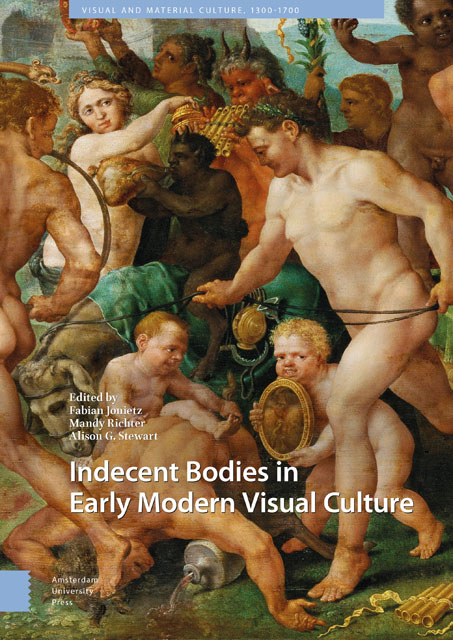Book contents
- Frontmatter
- Table of Contents
- List of Illustrations
- Indecent Bodies in Early Modern Visual Culture: An Introduction
- 1 Taste, Lust, and the Male Body: Sexual Representations in Early Sixteenth-Century Northern Europe
- 2 Private Viewings: The Frankfurt Context of Sebald Beham’s Die Nacht
- 3 To Show or Not to Show? Marcantonio Raimondi and the Representation of Female Pubic Hair
- 4 Treating Bodily Impurities: Skin, Art, and Medicine
- 5 Indecent Exposure and Honourable Uncovering in Renaissance Portraits of Women
- 6 Lust in Translation: Agency, Sexuality, and Gender Configuration in Pauwels Franck’s Allegories of Love
- 7 ‘So this guy walks into a forest…:’ obscenity, humour, sex, and the equine body in hans baldung’s Horses in a forest woodcuts (1534)
- 8 Indecent Creativity and the Tropes of Human Excreta
- 9 ‘It All Turns to Shit’ – The Land of Cockaigne in Sixteenth-Century German Woodcuts
- 10 Noëls and Bodily Fluids: The Business of Low-Country Ceremonial Fountains
- Index
3 - To Show or Not to Show? Marcantonio Raimondi and the Representation ofFemale Pubic Hair
Published online by Cambridge University Press: 19 April 2023
- Frontmatter
- Table of Contents
- List of Illustrations
- Indecent Bodies in Early Modern Visual Culture: An Introduction
- 1 Taste, Lust, and the Male Body: Sexual Representations in Early Sixteenth-Century Northern Europe
- 2 Private Viewings: The Frankfurt Context of Sebald Beham’s Die Nacht
- 3 To Show or Not to Show? Marcantonio Raimondi and the Representation of Female Pubic Hair
- 4 Treating Bodily Impurities: Skin, Art, and Medicine
- 5 Indecent Exposure and Honourable Uncovering in Renaissance Portraits of Women
- 6 Lust in Translation: Agency, Sexuality, and Gender Configuration in Pauwels Franck’s Allegories of Love
- 7 ‘So this guy walks into a forest…:’ obscenity, humour, sex, and the equine body in hans baldung’s Horses in a forest woodcuts (1534)
- 8 Indecent Creativity and the Tropes of Human Excreta
- 9 ‘It All Turns to Shit’ – The Land of Cockaigne in Sixteenth-Century German Woodcuts
- 10 Noëls and Bodily Fluids: The Business of Low-Country Ceremonial Fountains
- Index
Summary
Abstract
In the visual arts of Early Modern period, female pubic hair was mostlyconsidered indecorous, troublesome, or even indecent because ithighlighted one's most intimate parts. In treatises and medicalliterature of that period, it was perceived, as body hair in general, asa vehicle for the expulsion of the body's own excretions. Inaddition to these rather unbecoming connotations, this article willaddress and propose more positive ideas surrounding a particular set ofdepictions of pubic hair that referenced a specific artistic model. Iwill show that Marcantonio Raimondi's application of pubic hairto some of his female nudes, the Venus Wringing herHair, Young Man Protected by Fortune, andMars, Venus, and Cupid, all created between 1506and 1508, becomes a highly significant detail that should be seen inconnection with his imitation and emulation of Albrecht Dürer.Marcantonio's different approaches to pubic hair indicate alsoits potential as a field of artistic experimentation.
Keywords: Albrecht Dürer; artistic imitation; femalenude; Marcantonio Raimondi; pubic hair
In the visual arts of the Early Modern period, female pubic hair was mostlyconsidered indecorous, troublesome, or even indecent because it highlightedone's most intimate parts. In treatises and medical literature ofthat period, it was perceived In addition to these rather unbecomingconnotations, this article will address and propose more positive ideassurrounding a particular set of depictions of pubic hair that referenced aspecific artistic model. I will show that Marcantonio Raimondi'sapplication of pubic hair to some of his female nudes, created between 1506and 1508, becomes a highly significant detail that should be seen inconnection with his imitation and emulation of Albrecht Dürer.Marcantonio's different approach to pubic hair indicates also itspotential as a field of artistic experimentation.
In real life, body hair, including pubic hair, defines or marks physicaldifferences, in particular between human and animal, male and female, adultand child, even though such an understanding should be applied to the visualarts only with caution. Individual case studies have shown that theunderstandings of depictions of pubic hair could vary depending on time andplace, hold nuanced meanings, and be conditioned by very differentconsiderations.
- Type
- Chapter
- Information
- Indecent Bodies in Early Modern Visual Culture , pp. 87 - 108Publisher: Amsterdam University PressPrint publication year: 2022



